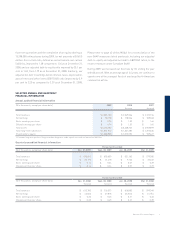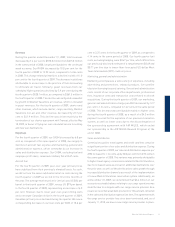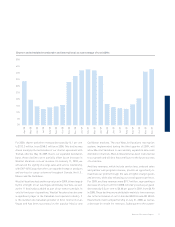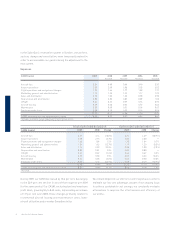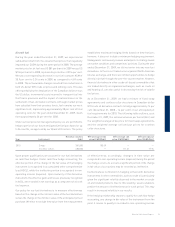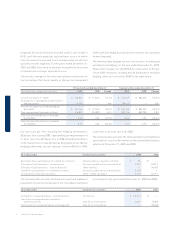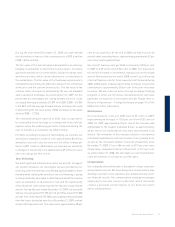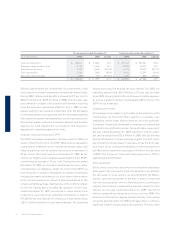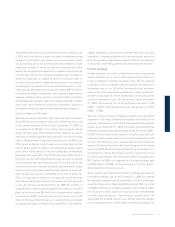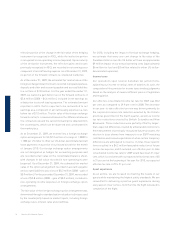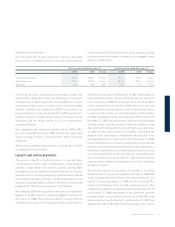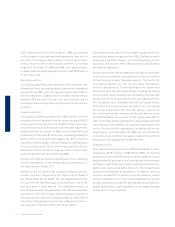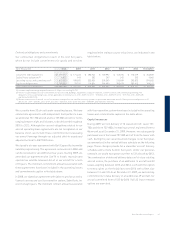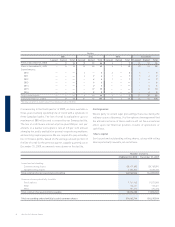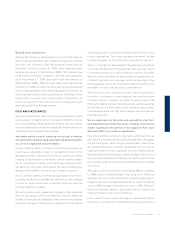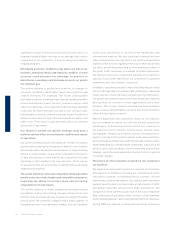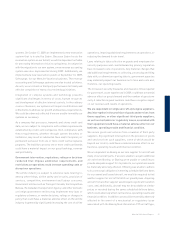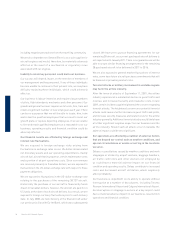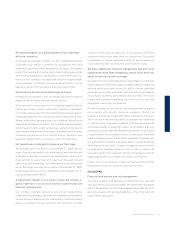Westjet 2009 Annual Report Download - page 49
Download and view the complete annual report
Please find page 49 of the 2009 Westjet annual report below. You can navigate through the pages in the report by either clicking on the pages listed below, or by using the keyword search tool below to find specific information within the annual report.
WestJet 2009 Annual Report 19
eligible employees, acceleration of expense due to an executive
leaving the Company and additional share unit grants under this
plan. Stock-based compensation expense related to the ESU plan
is included in marketing, general and administration expense.
Foreign exchange
Foreign exchange risk is the risk that the fair value of recognized
assets and liabilities or future cash fl ows would fl uctuate as a
result of changes in foreign exchange rates. We are exposed
to foreign currency exchange risks arising from fl uctuations in
exchange rates on our US-dollar-denominated net monetary
assets and certain operating expenditures, mainly aircraft fuel,
aircraft leasing expense, certain maintenance costs and a portion
of airport operations costs. During the year ended December
31, 2009, the average US-dollar exchange rate was 1.1425
(2008 – 1.0651), with the period-end exchange rate at 1.0510
(2008 – 1.2180).
The gain or loss on foreign exchange included in our consolidated
statement of earnings is mainly attributable to the effect of the
changes in the value of our US-dollar-denominated net monetary
assets. As at December 31, 2009, US-dollar-denominated net
monetary assets totalled approximately US $19.9 million (2008 –
US $99.5 million) and consist mainly of US-dollar cash and cash
equivalents and security deposits on various leased and fi nanced
aircraft, US-dollar accounts payable and accrued liabilities
and our US-dollar long-term debt facility signed in the fourth
quarter of 2009. We hold US-denominated cash and short-term
investments to reduce the foreign currency risk inherent in our
US-dollar expenditures. We reported a foreign exchange loss of
$12.3 million in 2009, as compared to a foreign exchange gain
of $30.6 million in 2008, on the revaluation of our US-dollar-
denominated net monetary assets.
We periodically use fi nancial derivatives to manage our exposure
to foreign exchange risk. As at December 31, 2009, we entered
into foreign exchange forward contracts for US $7.3 million per
month for the period of February 2010 to October 2010, for a total
of US $65.4 million at a weighted average contract rate of 1.0671
per US dollar to offset a portion of our US-dollar-denominated
aircraft lease payments. Upon proper qualification, we
designated the forward contracts as effective cash fl ow hedges
for accounting purposes. Under cash fl ow hedge accounting, the
somewhat by the effect of a new retirement policy, effective July
3, 2009, which resulted in a greater number of employees being
eligible for retirement than under our previous policy. Under
our accounting policy for stock-based compensation, for any
employees eligible to retire during the vesting period of the
award, the compensation expense is recognized over the period
from the grant date to the retirement eligibility date. In instances
where an employee is eligible to retire on the grant date of
the stock-based award, compensation expense is recognized
immediately. As a result of the new retirement policy, a one-
time catch-up adjustment was recognized during 2009 in relation
to retirement-eligible employees. Stock-based compensation
expense related to pilots’ options is included in fl ight operations
and navigational charges, while the expense related to senior
executives’ and certain non-executive employees’ options is
included in marketing, general and administration expense.
Executive share unit (ESU) plan
We have an equity-based ESU plan, whereby restricted share
units (RSU) and performance share units (PSU) may be issued
to our senior executive offi cers. As at December 31, 2009, up
to a maximum of 509,841 of our voting shares may be issued
under the ESU plan. Each RSU and PSU entitles the senior
executive to receive payment upon vesting in the form of voting
shares. We determine compensation expense for the RSUs and
PSUs based on the fair market value of our voting shares at the
time of grant, which is equal to the weighted average trading
price of our voting shares for the fi ve trading days immediately
preceding the grant date. The RSUs time vest at the end of a
three-year period, with compensation expense being recognized
in net earnings over the vesting period. PSUs time vest at the
end of a three-year term and incorporate performance criteria
based on achieving compounded average diluted earnings per
share growth rate targets established at the time of grant. For
PSUs, compensation expense is recognized in net earnings
over the vesting period based on the number of units expected
to vest. For the year ended December 31, 2009, $1.4 million in
compensation expense was recognized in relation to the ESU
plan, an increase from $0.9 million in compensation expense
recognized in 2008. These increases were mainly due to the
effect of the new retirement policy, resulting in the accelerated
recognition of expense related to RSUs and PSUs for retirement-


